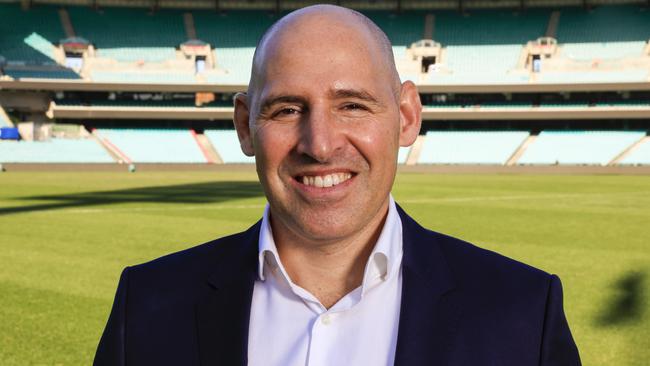The challenges awaiting Cricket Australia’s new boss Nick Hockley
The job was always Nick Hockley’s to lose, and he did better than that in 2020-21, looking like a trustworthy and collaborative team builder.

The headline “Hockley becomes CA CEO” was as foreseeable as “Steve Smith Does Quirky Steve Smith Thing” or “Channel Seven wants rights discount because it reckons …”.
A few months ago there was an eagerness at Jolimont simply to appoint him. Eventually it was decided to shore the process up by at least going through an executive search, run by Maritana Partners.
But once ensconced, the job was always Hockley’s to lose, and he did better than that in 2020-21, looking like a trustworthy and collaborative team builder as he played to acknowledged strengths as an experienced events manager.
The question will now arise whether he has the versatility to take on the task of … well, everything else, in a highly-diversified business. That encompasses renewing the authority and purpose of an organisation that has arguably rested on not very laurelly laurels since securing a collective bargain with the players and broadcasting deals more than three years ago.
Board and executive turnover post-Sandpapergate, an uneasy response to the Longstaff Review, ongoing friction with Seven, and last year’s clumsily managed Covid stand-downs have taken their toll at Jolimont. A little healing is due, both internally and externally.
Cricket Australia has some remarkable, even underestimated, strengths. Its female players, for example, are lapping the competition for popular imagination. When Futures Sport polled fans on their favourite Big Bash League players in January, no fewer than four of the top 10 were women: Elysse Perry, Alyssa Healy, Meg Lanning and Beth Mooney. Can any Australian sport boast that such a high proportion of its leading players are female?
At the same time, Australia’s men rank fourth in Test cricket, have a squad that hardly seems to play, and a contract list containing only three batsmen despite the expenditure of tens of millions of dollars on a National Cricket Centre and more pretty pathways than the Botanic Gardens. The team enjoyed a popularity bounce post-The Test, but kvetching about Australian cricketers fleeing the Covid-wracked Indian Premier League revealed an undercurrent of residual cynicism about their manner and motivations.
CA has ragged bilateral relationships with other cricket countries, at best ambivalent at worst mistrustful relationships with its state association owners. It is committed to a strategic plan that has “Strategic Plan” written on it but on inspection proves neither strategic nor a plan. How the board signed off on something so vacuous is a mystery.
But, then, that’s not the only question that arises about this board, and its chairman Earl Eddings. For instance, how does four months elapse between Queensland Cricket’s nomination of Greg Rowell and his appointment as a director, two days after the vote for Hockley? Would it not have made sense that Rowell have a say in the CEO he was to work with?
A former first-class cricketer and a pillar of premier cricket with a sharp legal mind, Rowell is an excellent appointment to a board whose only other elite playing experience is provided by Mel Jones. How does it take a third of a year to work that out?
It’s my previously stated opinion that Eddings should not serve the second term he is seeking as chairman. Why? Because CA should have an outstanding chairman, and continuity for continuity’s sake is a prescription for mediocrity.
Eddings’ boosters like to boast of him having “the numbers” to secure a second term. It is the worst possible argument. CA must be administered on a collective not a majority basis, or else it is back where it started before board reform — Eddings’ predecessor David Peever didn’t see much but he saw that at least.
For as long as Eddings needs “the numbers”, he’ll be incapable of exercising any degree of leadership, which inevitably involves disappointing some for the sake of the greater good. As a bare minimum he needs to anoint a successor — a basic task of corporate governance that has somehow eluded him.
What about Hockley as a leader? He is temperamentally more a Mr Inside than a Mr Outside. He may struggle with the perception that he is “the board’s guy”, a willing and deferential tool. When he appeared alongside the Australian Cricketers’ Association’s Todd Greenberg recently, the gap in assurance was palpable.
CA CEOs have not set a high standard as public performers, James Sutherland’s 18 years of diffidence having been followed by Kevin Roberts’ 18 months of overconfidence. Hockley can surely find a vein that suits him, but he won’t have long. A new strategic plan is almost due; a post-Covid memorandum of understanding must be thrashed out in the next year; the broadcast media whose bounties have underwritten the game for 40 years are being transformed unrecognisably.
Hockley is also English, and his preferred sport was rugby. It is strange that I should mention this last, because it would once have been seen as doubly disqualifying. Sutherland and Roberts had both been first-class cricketers; so was another candidate for the CEO’s role interviewed by the board.
Does this matter? Not in the crude sense of whom Hockley supports in the Ashes, as he would hardly barrack against Australia, but in the general crickety-ness of the organisation I suspect it is a slight handicap, and not lightly dismissed. He is not there to give throwdowns, set fields or answer trivia questions, but a CEO is in the relationship business and needs every advantage.
After three tumultuous years, everyone in cricket will wish Hockley well, and have a stake in his success. Nobody expects a Superman, but he’ll need to be making some quick changes.



Like Clark Kent stepping into a phone box and stepping out in another business suit, Cricket Australia’s Nick Hockley this week took over his own job as CEO, its description amended by deletion of the word “acting”.